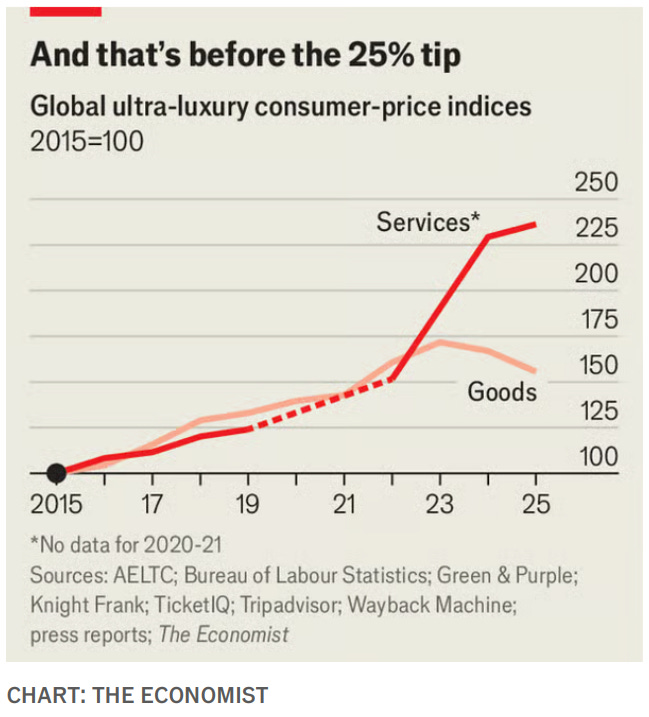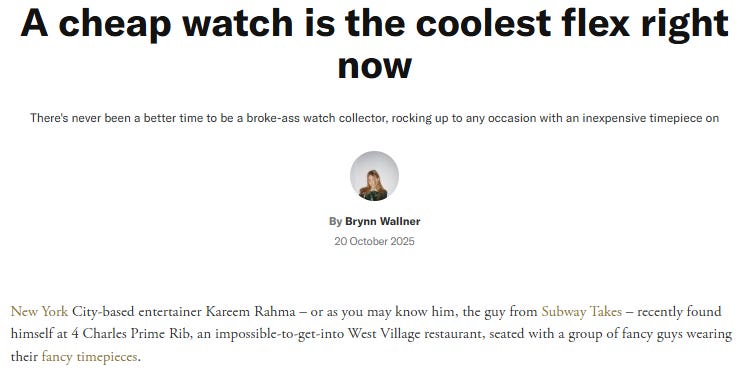The Attention Economy and Experiential Luxury
Why Watch Brands Must Compete for Your Time, Not Just Your Money
During a recent podcast, Nicholas Bowman-Scargill was reflecting on an evening event alongside Studio Underdog in New York; multiple watch events were happening simultaneously that evening across the city, and some people were hopping from one event to the next. He told the story with a mix of gratitude and wry amusement. Yes, he appreciated everyone who showed up, but he also recognised something fundamental - brands were competing for attention, more than anything else…
P.S. The typo in the podcast title (‘Nicolas’) was pointed out by the unofficial editor when I told him there were no mistakes in this post, after checking it several times. The guy is truly insufferable!
Estimated reading time: ~15 minutes
Nick’s observation had been rattling around in my head for a while, and then a friend1 shared this article from The Economist that clicked a few things into place. The article discussed the decline of traditional “luxury stuff” (Bordeaux wines, Rolexes, prime property in San Francisco) and highlighted the simultaneous surge in experiential luxury. A night at Le Bristol in Paris now costs twice what it did in 2019. Super Bowl tickets have doubled in price, and a five-year Wimbledon debenture has jumped from £50,000 to over £100,000. It continues:
“Attending the Met Gala, if you can get a ticket, costs over twice as much as in 2019. The price of the menu at Benu, a three-Michelin-star restaurant in San Francisco, has risen by 78% since 2015. Was it worth the more than $500 that your correspondent paid to eat the food? Maybe?”
The takeaway is that traditional luxury goods have lost their “rivalrousness.”2 Lab-grown diamonds look identical to mined ones, and anyone with enough cash can charter a private jet or buy otherwise ‘exclusive’ clothing off Vinted. The Economist’s luxury goods index is down 6% since 2023 and yet, their ultra-luxury-services index (the experiences money can buy) has gone up 90% since 2019.
Seth Godin recently framed this in a blog post, describing attention itself as being a luxury good:
By choosing to read an entire book, attend a concert in person, or engage deeply with nuance and narrative instead of scrolling for quick takeaways, you signal something. You demonstrate that you can afford to ‘waste’ attention on experiences that bring no optimised outcome, no efficiency gain, nor checkbox completion.
Watches in the attention economy
What does this mean for watches? It might just be that we’re experiencing a shift in what value creation means for the watch industry. A physical watch itself may be losing some of its status power. Anyone can walk into a grey dealer with enough cash and leave with a Nautilus; this is the proverbial private jet in watch terms. Lab-grown sapphires are indistinguishable from natural ones, and even the rarest watches end up on Instagram; this makes them feel less rivalrous than they actually are.
In fact, just this week, GQ published this article which reinforces my point:
Who would have thought?!
Now, what people can’t easily replicate is being one of 10 people at a private Romain Gauthier workshop tour in Vallée de Joux. You cannot fake attending a Moser client event at a Grand Prix. You cannot buy your way into Journe’s monthly apéritif if you’re not part of that community. These experiences are, therefore, “rivalrous” because if you’re there, someone else is not.
RedBar deserves enormous credit for recognising this a while ago; they built an entire organisation around experiential watch collecting. The watches at their brand-events are often not even for sale. The point of being there is the gathering itself, the conversations, the access to watchmakers, and the shared enthusiasm. That attention which collectors give to the event, and receive from the community, creates value that no Instagram post can capture.
CRM revolution
I’ve written before about how watch brands need to innovate beyond just making better watches.3 They now need to innovate in client services and relationships. It feels like this is becoming less optional, and more existential.




